
Veg Korean Kimchi Recipe

Veg Korean Kimchi Recipe
Table of Contents
ToggleVeg Korean Kimchi Recipe, Korean cuisine is sweeping across India — from spicy ramen to Bibimbap, but nothing says “K-food” like Kimchi. This iconic fermented side dish made with cabbage and radish is to Koreans what mango pickle is to Indians — an absolute mealtime essential!
But here’s the twist. Traditional kimchi is often non-vegetarian, thanks to ingredients like fish sauce. So what do we do in India, where vegetarian options are preferred or sometimes essential?
We desify it! Presenting: Desi Veg Kimchi — made with locally available ingredients, packed with bold, tangy, spicy flavors and fermented goodness, minus the fish sauce. While it may not be 100% authentic, I guarantee it hits the right flavor notes — with desi ingredients, desi tadka, and a whole lotta heart.
| Quantity | Servings |
|---|---|
| 1x | Small Jar (2-4 Servings) |
| 2x | Medium Jar (6-8 Servings) |
| 4x | Large Jar (10-12 Servings) |
Instead of Korean gochugaru (red pepper flakes), we use soaked dried red chillies, garlic, ginger, tomato ketchup, vinegar, and sugar. This magical combo replicates the fermented umami of fish sauce while keeping it vegetarian — spicy, tangy, and deep in flavor!
Soaked dried red chillies – 10 (for 1x)
Garlic – 4-5 cloves
Ginger – 1-inch piece
Tomato ketchup – 2 tbsp
Vinegar – 2 tbsp
Sugar – 1 tsp
Napa cabbage or regular cabbage – 1 medium (cut into chunks)
White radish (mooli) – 1 small (thin slices/sticks)
Carrots – 1 (julienned or grated)
Green onions – 4 stalks (halves and finger-length cuts)
Salt – 2 tbsp (for marination)
Rice flour – 2 tbsp
Water – 1 cup (for slurry)
Soy sauce – 1 tbsp
Roasted sesame seeds – 1 tbsp
Soak dried red chillies in water for 1 hour until they puff up.
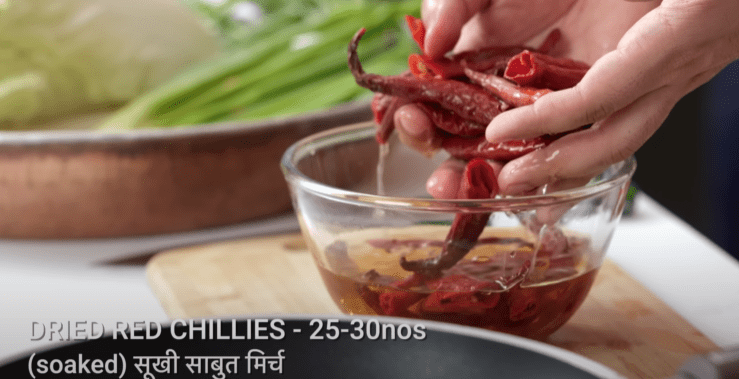
Add chillies with soaked water into a pan.
Add garlic & ginger.
Boil until water reduces.
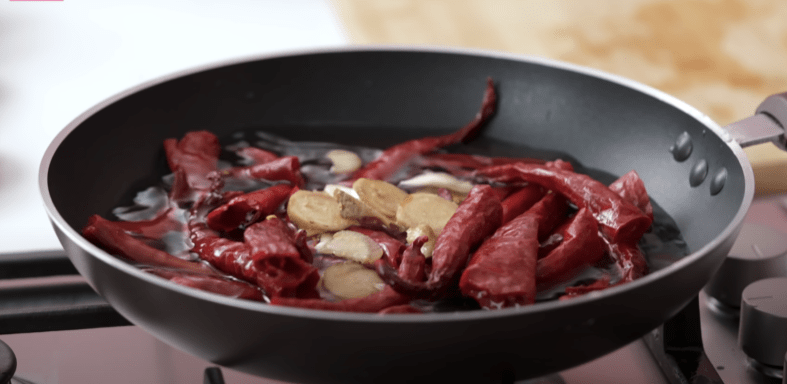
Use Napa or regular cabbage.
Pull leaves, remove stem, and chop into large chunks.
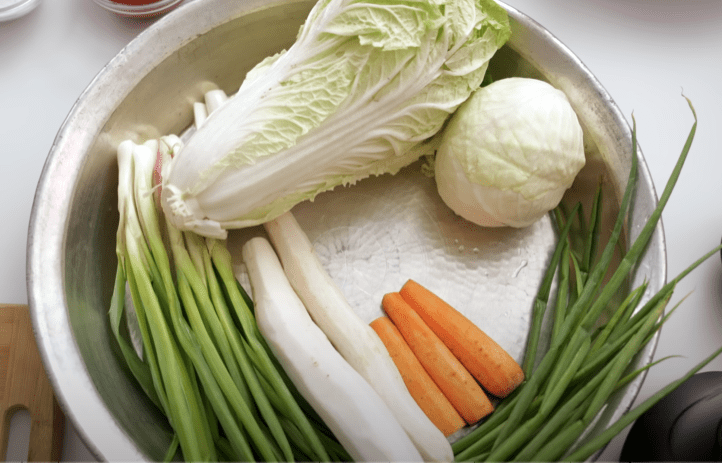
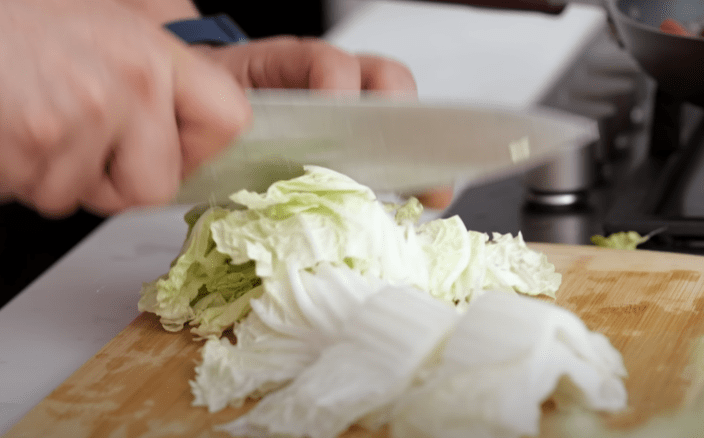
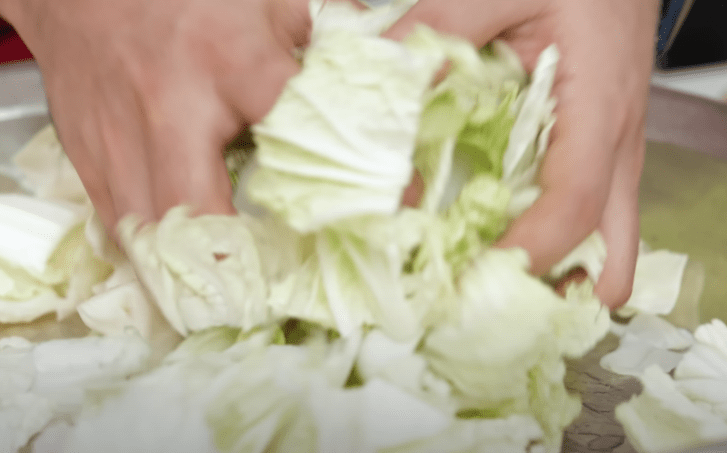
Thinly slice radish and carrots.
Cut green onion bulbs and green parts.
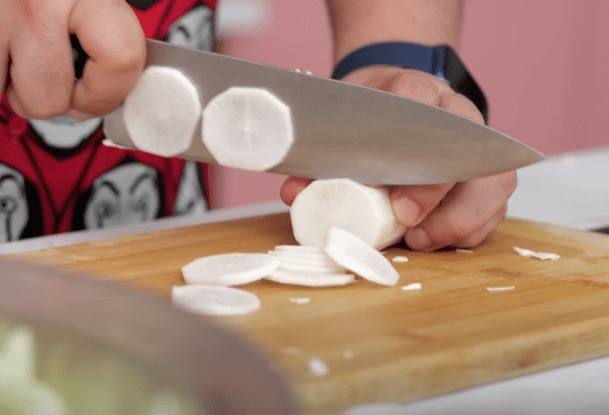

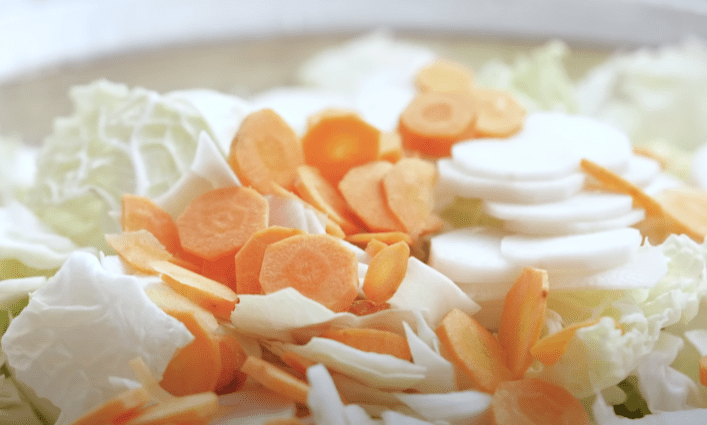
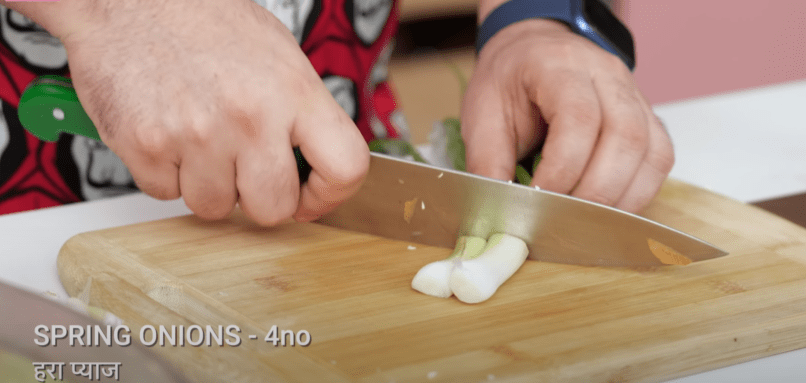
Mix all chopped vegetables in a large bowl.
Add salt generously.
Let it rest uncovered for 1 hour to release water and soften.


Blend boiled chillies, garlic, and ginger with vinegar, ketchup, and sugar until smooth.



Wash salted veggies under cold water (twice).
Squeeze out excess water and strain.



Mix water and rice flour.
Boil until thick; let it cool.

In a bowl: add strained veggies, chilli paste, soy sauce, sesame seeds, and slurry.
Mix thoroughly using gloved hands.





The magic moisture in this kimchi doesn’t come from water — it’s all about natural vegetable juices mixed with a thick rice flour slurry. This slurry not only binds the sauce but also adds body and depth to the flavor, creating that luscious, spreadable texture. Think of it as the chutney to your samosa — it holds everything together beautifully!
Don’t skip salt marination – It’s the key to water release and shelf-life.
Use gloves – Mixing the paste with bare hands can burn.
Thin slicing = fast fermentation – Especially for radish and carrots.
Vinegar is essential – Replaces fermentation tang if you eat it early.
Add jaggery instead of sugar – For a healthier, earthy twist.
Use mustard oil for desi punch – Optional but delicious.
You can add beetroot – For color and mild sweetness.
Want authentic umami? Add miso paste – Still veg!
Don’t keep near sunlight while fermenting – A dark, cool corner works best.
Always use clean, dry jars – Moisture = spoilage.
Once mixed, pack it tightly into sterilized glass jars. Press down to remove air bubbles. Seal the jars and let them sit at room temperature for 1-2 days to ferment.
After that, refrigerate. Kimchi gets better with age — flavors deepen and tanginess increases. Shelf life? Up to 3 months, easily!
Yes, but… with conditions.
Freezing kimchi is not ideal, but if you must:
Use airtight freezer-safe bags or containers.
Portion it into small batches.
Label with the date.
Upon thawing, the texture may become softer, and the taste more pungent. Use thawed kimchi for soups, stews, or kimchi fried rice — rather than eating it raw.
💬 Rahul K., long-time kimchi skeptic, now a loyal fan:
“I never thought a vegetarian kimchi could pack this much punch. The texture, the tang, the spice — it’s better than any restaurant kimchi I’ve tried. And the best part? I didn’t miss the fish sauce at all!”
Soak chillies for 1 hour.
Boil chillies with garlic & ginger.
Chop cabbage, radish, carrots, onions.
Salt and rest vegetables (1 hour).
Blend chilli paste with ketchup, vinegar & sugar.
Rinse veggies and squeeze out water.
Prepare and cool the rice flour slurry.
Mix all ingredients and store.
| Nutrient | Amount |
|---|---|
| Calories | 40 kcal |
| Carbohydrates | 7g |
| Protein | 1.5g |
| Fat | 0.5g |
| Fiber | 2g |
| Sodium | 450mg |
| Vitamin A | 25% DV |
| Vitamin C | 35% DV |
| Probiotics | ⭐ High |
👉 Watch Full Veg Kimchi Recipe Here (replace this with your actual link)
Yes! While Napa cabbage has a softer texture, regular cabbage works just fine. Just chop it into bite-sized pieces and salt it well.
Traditionally, yes. But you can eat this one instantly — the longer it sits, the deeper the flavor becomes.
Absolutely. It’s loaded with probiotics, vitamins, and fiber — a great way to boost gut health.
Yes. Reduce the number of dried red chillies and add a little more sugar or ketchup to balance the heat.
If it smells rotten (not just sour), develops mold, or turns slimy — it’s time to toss it. Refrigeration helps avoid this.